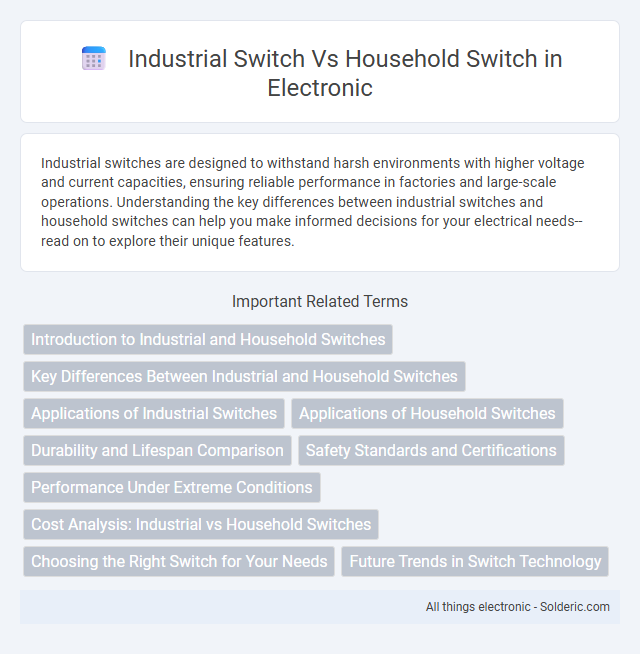Industrial switches are designed to withstand harsh environments with higher voltage and current capacities, ensuring reliable performance in factories and large-scale operations. Understanding the key differences between industrial switches and household switches can help you make informed decisions for your electrical needs--read on to explore their unique features.
Comparison Table
| Feature | Industrial Switch | Household Switch |
|---|---|---|
| Purpose | Controls heavy machinery and industrial equipment | Manages lighting and small appliances in homes |
| Durability | High durability, built for harsh environments | Standard durability for indoor use |
| Voltage Rating | Often rated for 240V and above | Typically rated for 120V or 240V |
| Current Capacity | Supports high current loads (10A to 100A+) | Supports low current loads (up to 15A) |
| Material | Industrial-grade metals and robust plastics | Common plastics and basic metals |
| Safety Features | Enhanced features like overload protection, IP ratings | Basic safety functions for household use |
| Installation | Requires professional installation and wiring | Simple installation, often DIY capable |
| Cost | Higher cost due to robust build and features | Lower cost, mass-produced for consumers |
| Applications | Factories, plants, heavy equipment control | Residential lighting and appliances |
Introduction to Industrial and Household Switches
Industrial switches are designed to handle high voltage, heavy current loads, and harsh environmental conditions typical in manufacturing and industrial settings, ensuring durability and reliability. Household switches are intended for lower voltage and current applications within residential environments, prioritizing ease of use and safety for everyday electrical devices. Differences in materials, design standards, and functionality reflect their distinct operational requirements and safety certifications.
Key Differences Between Industrial and Household Switches
Industrial switches are designed with higher voltage and current ratings, built to withstand harsh environmental conditions such as dust, moisture, and extreme temperatures, unlike household switches which cater to lower electrical loads in controlled indoor settings. Industrial switches often feature robust materials, enhanced durability, and compliance with specific industry standards (e.g., IEC, UL) to ensure safety and reliability in manufacturing or automation applications. Household switches prioritize aesthetic design, ease of installation, and compatibility with residential wiring systems, focusing primarily on user convenience rather than heavy-duty operational demands.
Applications of Industrial Switches
Industrial switches are engineered for demanding environments such as manufacturing plants, automation systems, and heavy machinery, where high durability and resistance to dust, moisture, and vibrations are essential. They are commonly used in conveyor systems, control panels, and safety interlocks to ensure reliable operation in harsh conditions. Unlike household switches, which prioritize aesthetic design and basic functionality, industrial switches support complex electrical loads and meet stringent safety standards required in industrial applications.
Applications of Household Switches
Household switches are primarily designed for residential electrical systems, controlling lighting fixtures, fans, and small appliances with standard voltage levels. They feature user-friendly designs and safety mechanisms suitable for everyday domestic environments, ensuring reliable operation in kitchens, living rooms, and bedrooms. Unlike industrial switches, they are not intended for heavy-duty or high-current applications, emphasizing convenience and aesthetics over robust durability.
Durability and Lifespan Comparison
Industrial switches are engineered for extreme durability, often featuring robust materials and designs that withstand harsh environments, high voltage, and frequent usage, resulting in a lifespan that far exceeds that of household switches. Household switches are typically designed for lighter loads and less frequent use, with materials and construction suitable for indoor residential settings, leading to shorter longevity under heavy or demanding conditions. Your choice between industrial and household switches should consider these differences to ensure reliable performance and extended service life in the intended application.
Safety Standards and Certifications
Industrial switches comply with rigorous safety standards such as IEC 60947 and UL 508, ensuring durability and protection against high voltage and harsh environments. Household switches typically adhere to standards like UL 20 and IEC 60669, designed for lower voltage and everyday use safety. Your choice should consider these certifications to match the specific safety requirements of your application.
Performance Under Extreme Conditions
Industrial switches are designed to perform reliably under extreme conditions such as high temperatures, heavy vibrations, dust, and moisture, ensuring uninterrupted operation in demanding environments. Household switches typically lack the robust construction and advanced insulation needed to withstand such harsh conditions, making them unsuitable for industrial settings. If your application involves exposure to these severe conditions, choosing an industrial switch is crucial for safety and performance.
Cost Analysis: Industrial vs Household Switches
Industrial switches generally have a higher upfront cost compared to household switches due to their robust design, enhanced durability, and ability to handle higher electrical loads. Your investment in industrial switches ensures long-term savings by reducing maintenance and replacement expenses, while household switches are more affordable but may require frequent replacements in high-demand settings. Choosing between the two depends on balancing initial cost against performance requirements and overall lifecycle expenses.
Choosing the Right Switch for Your Needs
Industrial switches are designed to handle high voltage and heavy-duty operations, making them suitable for environments with demanding electrical loads and harsh conditions. Household switches prioritize safety, ease of use, and compatibility with low-voltage circuits typically found in residential settings. Choosing the right switch for your needs involves assessing the electrical load, environmental factors, and durability requirements to ensure optimal performance and longevity.
Future Trends in Switch Technology
Industrial switches are evolving with innovations such as smart connectivity, enhanced durability, and integration with IoT for predictive maintenance and real-time monitoring, setting them apart from traditional household switches. Household switches are similarly advancing with touch-sensitive panels, voice control compatibility, and energy-efficient designs aimed at improving user convenience and reducing power consumption. The future of switch technology emphasizes automation, smart home integration, and robust performance across both industrial and residential applications.
industrial switch vs household switch Infographic

 solderic.com
solderic.com